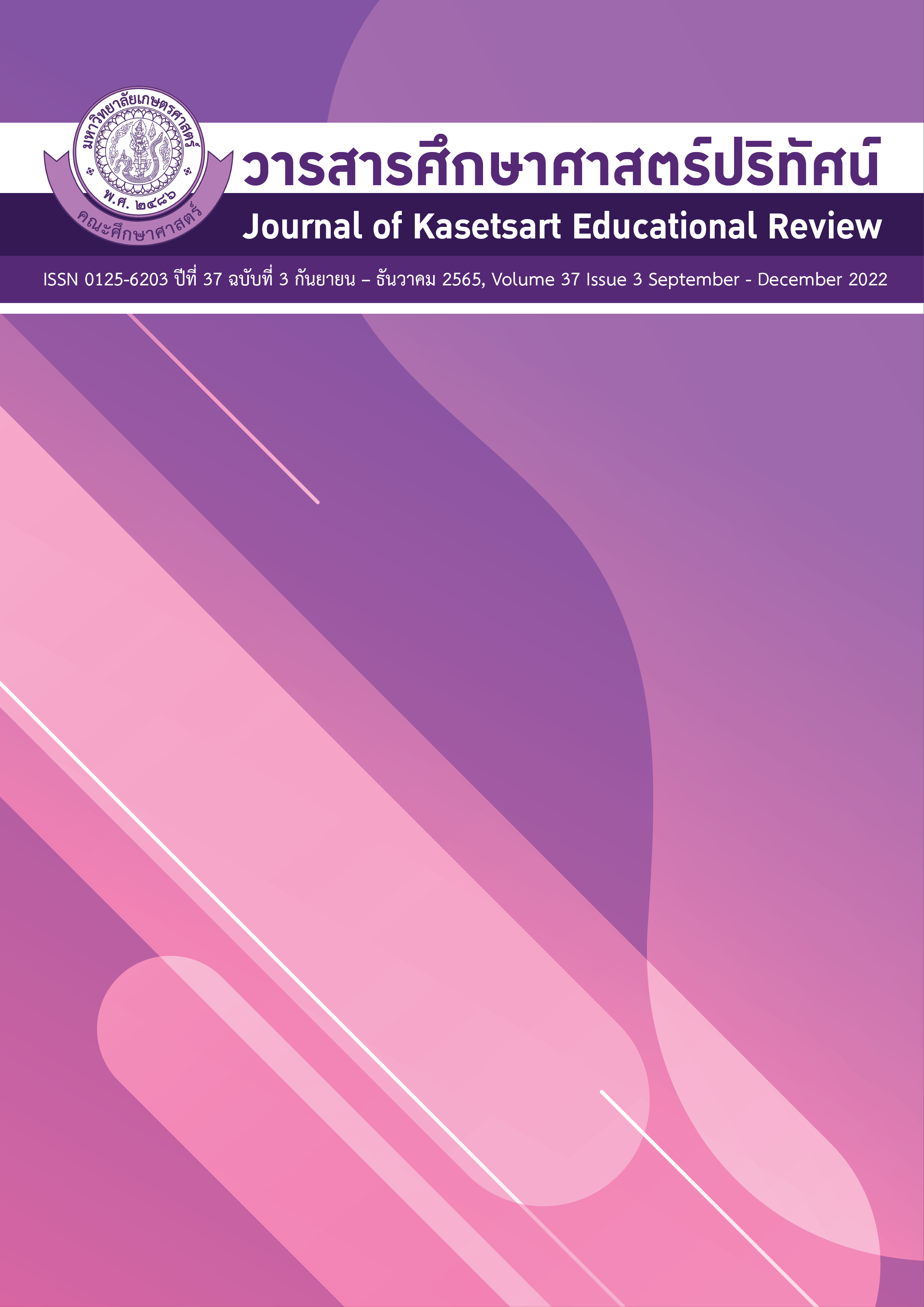ผลการจัดกิจกรรมศิลปะที่เน้นกระบวนการที่มีต่อการคิดเชิงบริหารสมอง ด้านทักษะปฏิบัติของเด็กปฐมวัย
คำสำคัญ:
ศิลปะที่เน้นกระบวนการ, ทักษะปฏิบัติ, เด็กปฐมวัยบทคัดย่อ
การวิจัยนี้มีวัตถุประสงค์เพื่อศึกษาผลการจัดกิจกรรมศิลปะที่เน้นกระบวนการที่มีต่อการคิดเชิงบริหารสมองด้านทักษะปฏิบัติของเด็กปฐมวัย โดยมีกลุ่มตัวอย่างคือ เด็กปฐมวัยชายและหญิง 30 คน อายุระหว่าง 4-5 ปี ที่กำลังศึกษาอยู่ในชั้นอนุบาลปีที่ 2 ภาคเรียนที่ 2 ปีการศึกษา 2563 โรงเรียนอนุบาลสุพรรณบุรี สำนักงานเขตพื้นที่การศึกษาประถมศึกษาสุพรรณบุรี เขต 1 ได้มาด้วยวิธีการสุ่มแบบกลุ่ม (Cluster Sampling) เครื่องมือที่ใช้ในการศึกษา คือ แผนการจัดกิจกรรมศิลปะที่เน้นกระบวนการ จำนวน 8 สัปดาห์ 24 แผน และแบบประเมินเชิงปฏิบัติการทักษะปฏิบัติของเด็กปฐมวัย 3 ด้าน ประกอบด้วย
ด้านการวางแผนจัดระบบดำเนินการ ด้านการริเริ่มและลงมือทำ และด้านการมุ่งเป้าหมาย วิเคราะห์ข้อมูลด้วยการหาค่าเฉลี่ย ส่วนเบี่ยงเบนมาตรฐาน และวิเคราะห์ข้อมูลเชิงคุณภาพโดยการวิเคราะห์เนื้อหาและบรรยายเชิงพรรณนา
ผลการวิจัยพบว่า เด็กปฐมวัยที่ได้รับการจัดกิจกรรมศิลปะที่เน้นกระบวนการมีทักษะปฏิบัติสูงกว่าก่อนการทดลองอย่างมีนัยสำคัญทางสถิติที่ระดับ .05 ประกอบด้วย ด้านการวางแผนจัดระบบดำเนินการ ด้านการริเริ่มและลงมือทำ และด้านการมุ่งเป้าหมาย เมื่อเด็กได้รับการจัดประสบการณ์การเรียนรู้ศิลปะ
ที่เน้นกระบวนการอย่างต่อเนื่องเป็นประจำ เด็กสามารถ วางแผนการทำงานของตนเองได้ มีการริเริ่ม
การแก้ปัญหาเฉพาะหน้าได้ดีขึ้น อีกทั้งสามารถวางเป้าหมายได้ชัดเจน จนทำให้ประสบความสำเร็จในการทำกิจกรรมต่าง ๆ
เอกสารอ้างอิง
Chinothai, H. (2010). Problem Solving Ability of Kindergarten Presented with Vegetable Food Activities. Retrieved December 2, 2020, from http://thesis.swu.ac.th/swuthesis/Ear_Chi_Ed/Hatai_C.pdf. [in Thai]
Chuthaphakdikul, N. (2016, August). Developing EF Brain Skills for 21st Century Learning. At the Teachers Council Academic Conference. The meeting was organized by The Secretariat of the Teachers Council of Thailand, Vayupak Convention Center Centra Hotel Government Center and Convention Center Chaengwattana Road. [in Thai]
Chuthaphakdikul, N. et al. (2017). The Development of Standard Criteria for Assessing Executive Thinking in Early Childhood Children Bangkok: Neuroscience Research Center Institute of Molecular Biosciences, Mahidol University. [in Thai]
Diamond, A. (2012). Activities and Programs That Improve Children’s Executive Functions. Retrieved from https://pubmed.ncbi.nlm.nih.gov/ 25328287/.
Fortman, B. (2016). What is Process Art and Why is it Important?. Retrieved from https://dayearlylearning.org/why-your-childs-artwork-doesnt-look-like-it-should/.
Grace, H. (2015). The Importance of Art in ChildDevelopmenth. Retrieved November 10, 2020, from http://www.earlylearningcoalitionsarasota.org/pdf/2015/The%20Importance%20of%20Art%20in%20Child%20Development-May%202015.pdf.
Harnmethi, S. (2015). EF Immunity, Life and Drug Protection Handbook for kindergarten teachers. Bangkok: Rak Luk Books Printing House.
Kemket, W. (2008). Research Methods in Social Sciences. (2nd printing). Bangkok: Chulalongkorn University Printing House. [in Thai]
Leardvicha, P. (2014). Early Childhood Teaching Plan Best Pratices Teaching plan that corresponds to the mental development of children. Chiang Mai: Than Panya Company Limited. [in Thai]
Ministry of Education. (2017). Manual of Early Childhood Education Program 2017. Bangkok: The Agricultural Cooperative Association of Thailand Printing House Co., Ltd. [in Thai]
National Association for the Education of Young Children. (2014). How Process-Focused Art Experiences Support Preschoolers. Retrieved November 10, 2020, from https://www.naeyc.org/resources/pubs/tyc/feb2014/process-art-experiences.
Nanthalad, P. (2017). Early childhood art. M.S. (Early Childhood Education). Udon Thani Rajabhat University. [in Thai]
Ooppakarn, D. (2017). On the development of teaching and learning process in free activities according to the concept of intellectual tools and Brain-Based Learning to Promote Executive Functions of Kindergarten Children (Bachelor of Education, Chulalongkorn University, Bangkok) Retrieved December 25, 2020, from http://cuir.car.chula.ac.th/ [In Thai]
Ooppakarn, D., & Yanachai, O. (2018). For enhancing the cognitive development of early childhood children, which principles should be chosen: “brain-based learning” or “executive thinking”. Journal of Humanities Social Sciences and Arts, 11(1): 9. [In Thai]
Rauner. D. (2012). Make ‘Executive Functions’ A Priority in Early Education Policy, catalyst-chicago.org. Retrieved December 2, 2020, from http://catalyst-chicago.org
Rachelle. (2019). What is Process Art for Kids? Retrieved December 21, 2020, from https://tinkerlab.com/what-is-process-art-for-kids/.
Schirrmacher. (1988). Art and Creative Development for Young Children. New York: Delmar.
Sarakijprecha, V. (2018). Process Art. Retrieved from https://kukai.ac.th/process-art.php. [in Thai]
ดาวน์โหลด
เผยแพร่แล้ว
ฉบับ
ประเภทบทความ
สัญญาอนุญาต
ลิขสิทธิ์ (c) 2022 วารสารศึกษาศาสตร์ปริทัศน์

อนุญาตภายใต้เงื่อนไข Creative Commons Attribution-NonCommercial-NoDerivatives 4.0 International License.
บทความทุกบทความเป็นลิขสิทธิ์ของวารสารคณะศึกษาศาสตร์ มหาวิทยาลัยเกษตรศาสตร์ วิทยาเขตบางเขน
วารสารศึกษาศาสตร์ปริทัศน์ (Kasetsart Educational Review)






